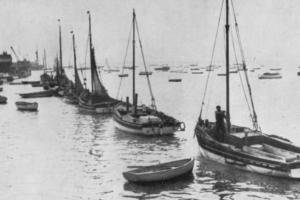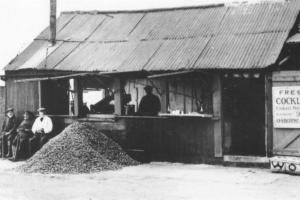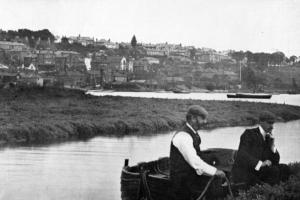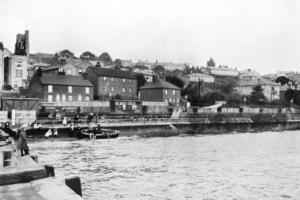Leigh Old Town

Leigh
Old
Town
or
“Old
Leigh”,
as
its
locally
known,
played
a
prominent
role
in
the
development
of
the
Borough
and
was
used
extensively
as
a
port
and
ship
building
centre in bygone days.
The
earliest
known
record
of
Leigh
is
the
entry
in
the
Doomsday
Book
of
1086.
At
around
1565
it
was
the
principal
port
between
Gravesend
and
Harwich,
and
was
the
landing place for goods destined for South Essex.
The
church
of
Leigh
stands
high
on
Leigh
hill
and
its
imposing
tower
has
been
a
landmark
for
seamen
for
400
years.
In
the
Churchyard
there
is
a
memorial
to
Captain
Brand,
R.N.,
who
was
midshipman
on
the
“Revenge”
at
the
Battle
of
Trafalgar.
Captain
Brand’s
father
was
also
a
naval
officer
and
gave
four
sons
to
the
service.
The
“Victory”
was
taken
to
Chatham
for
repair
after
the
Battle
of
Trafalgar,
and
lay
for
a
short
time
off
Southend.
The
first
of
many
ships
built
at
Leigh
was
the
“Speedwell”
a
ship
of
105
tonnes
built
in
1579,
and
in
1652,
after
the
first
of
three
battles
of
the
Dutch
War,
Admiral
Van
Tromp
inflicted
grave
damage
on
Admiral
Blake’s
fleet
off
the
Goodwin
Sands,
it
was
to
Leigh
that
he
brought
his
crippled
ships
for
refitting.
“The
Sands”
the
oldest
part
of
Leigh,
used
as
a
disembarkation
point
in
the
Middle
Ages,
is
said
to
have
been
where
the
“Mayflower”
moored
in
1620
before
sailing
to
the
New
World.
The
flour
she
took
aboard was milled at Billericay.
In
the
three
wars
with
the
Dutch,
Leigh
was
frequently
used
as
a
naval
base.
After
the
battle
with
Van
Tromp
off
Dover,
in
1652,
Blake
was
forced
to
retire
to
Leigh
to
refit
whilst
his
adversary
swept
the
Channel
with
a
broom
at
his
masthead.
Blake
had
his
revenge
in
the
following
year
when
he
sailed,
from
the
Estuary,
with
“the
most
numerous,
the
best
equipped,
and
the
most
ably
commanded
fleet
that
the
Commonwealth ever put to sea,” and finally defeated Van Tromp’s fleet off the Texel.
Several
years
after,
in
the
reign
of
Charles
II,
came
the
second
Dutch
War
with
the
entry
of
De
Ruyter
into
the
Thames
in
1667.
He
Burnt
Sheerness
Dockyard,
destroyed
several
warships
which
had
been
laid
up
in
the
Medway,
he
landed
on
Canvey
Island,
raided
cattle
and
did
other
damage.
The
landing
caused
immense
alarm
which
was
noted,
in
considerable
detail,
by
Samuel
Pepys
in
his
diary.
The
Essex
Militia
was
hastily
mobilised
with
the
greater
part
of
the
force
concentrated
at
Leigh
but,
beyond
damaging
British
prestige
and
causing
a
panic
that
reached
as
far
as
London
and
spread throughout the country, De Ruyter effected little harm.
In
1672
the
Dutch
also
had
local
interest,
as
it
was
in
one
of
the
battles
of
that
campaign
that
Sir
Richard
Haddock
won
distinction,
and
also
because
the
English
Fleet’s
headquarters were again in the Thames Estuary.
Leigh
later
became
known
as
a
prosperous
fishing
village.
Leigh
Old
Town
still
has
many
‘character
pubs’
like
“The
Crooked
Billet,”
an
oak
framed
building
of
the
early
16th
Century,
or
“the
Peter
Boat,”
built
on
the
side
of
a
weather
boarded
Inn
dated
1695,
rebuilt
after
it
was
completely
destroyed
in
1892:
the
cellar
of
the
original
building
is
said
to
have
been
used
by
smugglers.
Of
course
there
is
also
“The
Smack,”
formerly
a
coach
house
and
stables;
at
low
tide
the
south
wall
reveals
a
bricked
up
arch,
which
suggests
it
may
have
been
used
to
store
contraband
goods
as
the
river
offered
an
excellent entrance to the cellar of the building.

Bawleys at Leigh

Cockle Shed
Southend Timeline Southend-on-Sea © 2009 - 2024. All Rights Reserved

Leigh from the Marshes

Old Leigh from the Quay
Leigh-on-Sea
Smuggling
was
rife
in
the
district.
Every
creek
from
Benfleet
to
Battlesbridge
afforded
friendly
shelter.
Most
of
the
church
belfries
were
used
to
hide
liquor
and
other
smuggled
goods.
In
the
tower
of
Rochford
Church
were
stored
gin,
hollands
and
tea,
and
there
was
a
secret
cavity
under
the
pulpit
for
further
storage.
Magistrates
often
employed
their
servants
and
horses
in
transporting
goods
from
the
boats
to
the
hiding
places.
At
Leigh
ten
vessels,
ranging
from
ten
to
thirteen
tons,
were
used
in
this
illicit
traffic,
and
the
collector of Customs at Leigh made seizures every day.
Old Leigh still thrives to this day as a popular place to visit, drink, socialise, and of course to sample its famous seafood.



Website Info:

Southend-on-Sea’s No 1 History Website! Documenting The Town & The Townspeople
Now Incorporating The Sea Of Change Website


SOUTHEND CITY
Chalkwell ▪ Eastwood ▪ Leigh-on-Sea ▪ Prittlewell ▪ Shoeburyness ▪ Southchurch ▪ Thorpe Bay ▪ Westcliff-on-Sea
































































